Timeline: Myanmar protests
A look at the escalating protests sparked by fuel price rises in Myanmar.
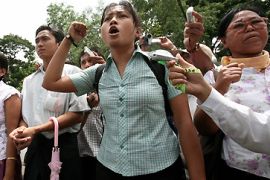
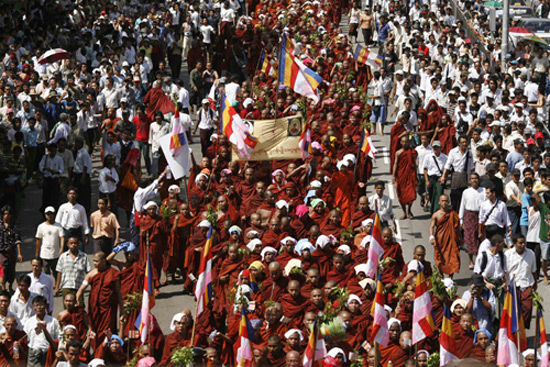 |
| The protests are the biggest the country has seen in two decades [Reuters] |
August 15 – Myanmar government imposes 100 per cent increase in fuel prices at state-owned petrol stations. The price of canisters of compressed natural gas also soars, rising by five times.
No warning is given, nor any reason for the price rise.
The price hike immediately causes transport costs to skyrocket, driving up prices for food and other essentials and adding to hardships faced by millions of Myanmar’s poor.
August 19 – Pro-democracy activists lead a rare public protest against price rises through the streets of the former capital, Yangon. Witnesses say up to 500 join the march.
The demonstration is led by activists of the 88 Generation Students group. The group is made up of former student leaders from the 1988 pro-democracy uprising, many of whom were jailed and tortured after the military crushed those protests.
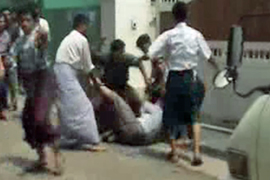 |
| Dozens of protesters have been beaten and arrested |
August 21 – State-run New Light of Myanmar newspaper reports arrest of 13 leaders of the fuel price protests for “undermining stability and security of the nation”.
Among those arrested is Min Ko Naing, one of Myanmar‘s most prominent activists and a member of the 88 Generation who spent 16 years in prison for his involvement in the 1988 uprising.
August 22 – Up to 300 protesters join a second protest march through Yangon. The march is broken up by members of the pro-government Union Solidarity and Development Association (USDA), backed up by police.
Witnesses say many USDA members disguised themselves as street sweepers before attacking the protesters, beating them with sticks.
Pro-democracy groups report arrests of several more activists
August 23 – Police and government supporters break up a third, much smaller, protest in Yangon.
More activists are taken away while journalists covering the protest report being roughed up by police and warned not to take pictures.
Exiled Myanmar pro-democracy groups based in Thailand cite sources reporting other fuel protests held in other cities in Myanmar.
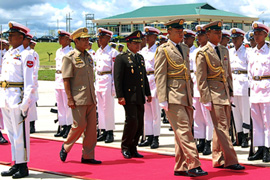 |
| Myanmar’s military rulers rarely tolerate public protests [AFP] |
August 24 – Amid continued tensions, reports emerge of government moves to tighten security, deploying more troops to Yangon and other key areas across the country.
Ban Ki-moon, the UN secretary general, urges Myanmar government to “exercise maximum restraint” in its response to protests.
August 25 – State run media accuses members of the 88 Generation Students of terrorism and having contacts with exiled groups.
It warns protest leaders could be charged with “harming the stability of the state” and could face up to 20 years in jail.
August 26 – Witnesses say leading democracy activist Htin Kyaw is beaten and arrested by plain clothes government supporters or agents following small protest in central Yangon.
August 27 – Fuel price protests reported in the northern towns of Bago and Mogok, shadowed by plain clothes police and members of the USDA.
August 28 – Police and USDA members break up pro-democracy protest in Yangon, arresting dozens. On the same day Buddhist monks join a protest against fuel price increases in the northwestern city of Sittwe.
August 30 – Group of detained pro-democracy protesters launch hunger strike, reportedly demanding medical treatment for a protester whose leg was broken by USDA members.
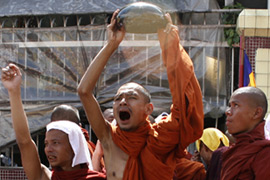 |
| Monks have been carrying their alms bowls upside down as a symbol of protest [Reuters] |
September 3 – Protesters begin 160 km march from town of Labutta to Yangon. Several marchers are arrested as police move in to beak up the demonstration before it reaches the former capital.
September 5 – Police and soldiers fire warning shots to break up protest by Buddhist monks in the northern town of Pakokku. Several monks are reportedly injured.
The incident is the first reported case of guns being used to break up demonstrations since the current round of protests began.
September 6 – A group of about 20 government officials are briefly held hostage by monks in Pakokku demanding apology after guns were fired during protests a day earlier.
September 9 – Government accuses opposition National League for Democracy (NLD) of using fuel price rises to instigate nationwide riots and unrest.
It warns that the protest could lead to the outlawing of the NLD.
September 18 – Buddhist monks hold string of protests in Yangon and other cities on anniversary of 1988 coup that brought current military regime to power. The monks say they will begin boycotting alms from members of the military government and their associates.
One protest in the northern city of Sittwe is broken up by police using tear gas and firing warning shots.
September 21 – Ibrahim Gambari, the UN’s special envoy on Myanmar, raises “serious concerns” over the growing political crisis, telling the Security Council recent developments “underscore the urgency to step up our efforts to find solutions to the challenges facing the country”.
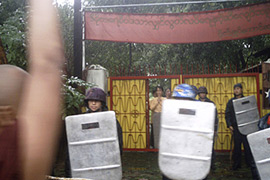 |
| Aung San Suu Kyi was in tears as she greeted the monks [Reuters] |
September 22 – Aung San Suu Kyi greets protesting monks from the house where she has been detained for 12 of the past 18 years after army allows about 2,000 people to pass a roadblock and gather by the democracy leader’s home.
Nuns join monks in protest for the first time.
September 24 – Monks call on sympathisers to join their marches as between 50,000 and 100,000 protesters take to Yangon’s streets.
September 25 – Thousands of monks and supporters again gather in defiance of government threats of a military crackdown.
Government imposes dusk-to-dawn curfew in Yangon and second biggest city of Mandalay.
Internet access is reportedly blocked.
September 26 – Soldiers and riot police deployed around at least six big monasteries in Yangon.
September 27 – At least nine people are killed, including a Japanese video journalist, after security forces use automatic weapons on protesters in Yangon.
Tens of thousands of people join protests that continue throughout the day.